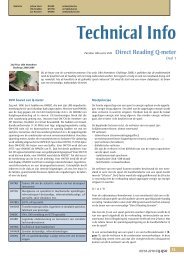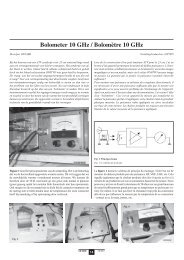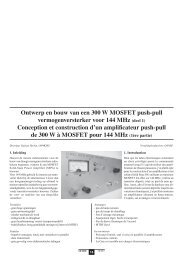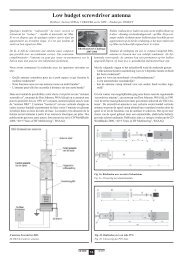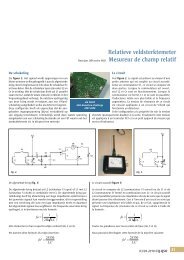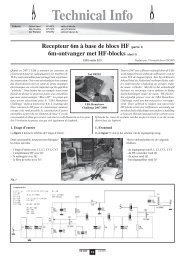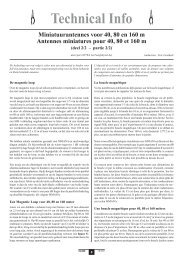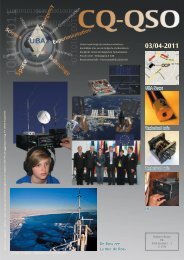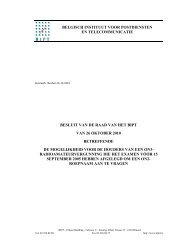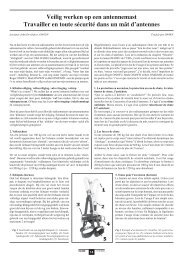IARU Region 1 VHF Managers Handbook - UBA
IARU Region 1 VHF Managers Handbook - UBA
IARU Region 1 VHF Managers Handbook - UBA
You also want an ePaper? Increase the reach of your titles
YUMPU automatically turns print PDFs into web optimized ePapers that Google loves.
8 Technical Recommendations of <strong>IARU</strong> <strong>Region</strong> 1<br />
8.1 An introduction<br />
In order to facilitate the operations of Amateur Radio Stations the <strong>IARU</strong> at its triennial conferences adopts<br />
Recommendations. Most of those are so-called "operational recommendations" ( such as band-plans and<br />
contest-rules ). But during the past 30 years several "technical recommendations" have been adopted as<br />
well.<br />
This note deals with the content and background of those technical recommendations.<br />
8.2 FREQUENCY MODULATED TELEPHONY<br />
8.2.1 The basic FM standard (Recommendation FM.1.)<br />
One of the longest standing <strong>IARU</strong> <strong>Region</strong> 1 technical recommendations, adopted at the <strong>Region</strong> 1<br />
Conference in Brussels (1969) deals with the basic parameters of Narrow Band FM Telephony. It states<br />
:"For FM within <strong>Region</strong> 1 a maximum modulation index of 1 and an audio band restricted to 3 kHz shall be<br />
used"<br />
Between 1963 and 1969 the gradual introduction of VFO controlled SSB, replacing AM( x-tal controlled),<br />
was taking place on <strong>VHF</strong>. At the same time, however, the problems with LF break-through in radio-, TV-<br />
and audio equipment became embarrassing. Using FM and PM appeared to be the right solution in this<br />
case. Of course the recently acquired habit of VFO control and co-channel working was used with FM as<br />
well.<br />
In order for an efficient use of FM it appeared necessary to agree upon a few basic parameters which<br />
would determine the optimum filter to be used in the receiver. A 12 kHz receiver bandwidth was finally<br />
chosen. This appeared to be the minimum value giving distinctly better quality than 6 kHz AM without<br />
showing too much of a threshold effect ( at least not much more than conventional AM ). Soon after the<br />
recommendation had been adopted several manufacturers of crystal-filters marketed 12 kHz wide filters.<br />
Almost 30 years later this basic recommendation still is in force, although VFO controlled FM has almost<br />
disappeared ( it still is used with rain-scatter on the microwaves ) and the majority of amateurs use crystalcontrolled<br />
FM transceivers with filters wider than 12 kHz, thus loosing several dB's in communications<br />
efficiency.<br />
It must be noted that the application of the recommendation is not limited to frequencies above 30 MHz. It<br />
equally well applies to the 29 MHz band, although it appears that FM on that band is often received with<br />
filters narrower than 12 kHz.<br />
Three years later, at the 1972 Scheveningen conference, a more detailed standard, largely based upon<br />
the first was adapted, but this time VFO control appeared to be out of fashion and the standard dealt with<br />
"Fixed channel FM stations". The audio response was specified more in detail as 300-3000 Hz with a 12<br />
dB/octave fall off outside this band and 6 dB/octave pre-emphasis.<br />
It appears sensible to combine those two recommendations into a single one at a future conference.<br />
<strong>IARU</strong> <strong>Region</strong> 1 page 114/148 Version 5.40<br />
<strong>VHF</strong> managers handbook




